- Home
- About Us
- Industry
- Services
- Reading
- Contact Us
Asia Pacific WiGig Market: Current Analysis and Forecast (2024-2032)
Emphasis on Product (Display Devices and Network Infrastructure Devices); Technology Type (System-On-Chip (SoC) and Integrated Circuit Chip (IC).); End-User Industry (BFSI, Healthcare, IT & Telecom, Retail, Media & Entertainment, and Others.); and Region/Country
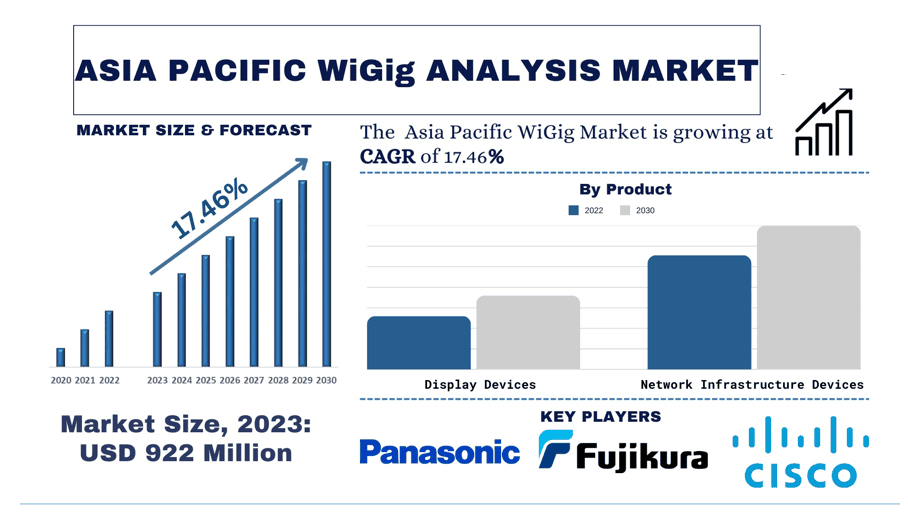
WiGig Market Size & Forecast
The Asia Pacific WiGig market was valued at USD 922 Million and is expected to grow at a strong CAGR of around 17.46% during the forecast period (2024-2032) owing to the proliferation of 5G network rollout in the region, coupled with increasing data-intensive application across the region.
WiGig Market Analysis
Wireless Gigabyte technology refers to high-speed wireless networking solutions that offer Gigabyte-level data transfer speeds over Wi-Fi connections. This technology enables faster and more efficient data transmission between devices without the need for physical cables. In essence, wireless Gigabyte facilitates rapid and reliable communication between devices, supporting applications requiring high bandwidth and fast data transfer rates.
With rapidly improving telecommunications infrastructure, increasing affordability of mobile data plans, and a thriving digital economy, the region is primed for explosive growth in wireless gigabyte usage in the coming years. The rollout of 5G networks across the Asia Pacific is a major catalyst fueling the demand for wireless gigabyte usage. 5G technology offers significantly higher data transfer speeds and lower latency compared to previous generations, enabling seamless streaming, cloud computing, and other data-intensive applications. For instance, according to the GSA (Global Mobile Suppliers Association), as of Q1 2023, 230 operators were investing in 5G across the Asia Pacific region, with major markets like China, South Korea, Japan, and Australia leading the way. China alone had deployed over 2 million 5G base stations by the end of 2022, accounting for over 60% of the global 5G infrastructure. Furthermore, the Asia Pacific region is home to a rapidly growing streaming industry, with major players like Netflix, Amazon Prime Video, Disney+, and local streaming services like Viu, iQIYI, and Hotstar catering to the region’s diverse content preferences. For instance, according to a report by Media Partners Asia, the number of streaming video subscribers in Asia Pacific is expected to reach 799 million by 2026, up from 421 million in 2020, representing a CAGR of 14%. Additionally, the Asia Pacific region is home to a young and tech-savvy population that is driving the demand for data-intensive internet applications, such as online gaming, social media, and cloud-based services. For instance, according to a report by Newzoo, the Asia Pacific region remains the largest global gaming market in 2022, with countries like China, Japan, and South Korea leading the way.
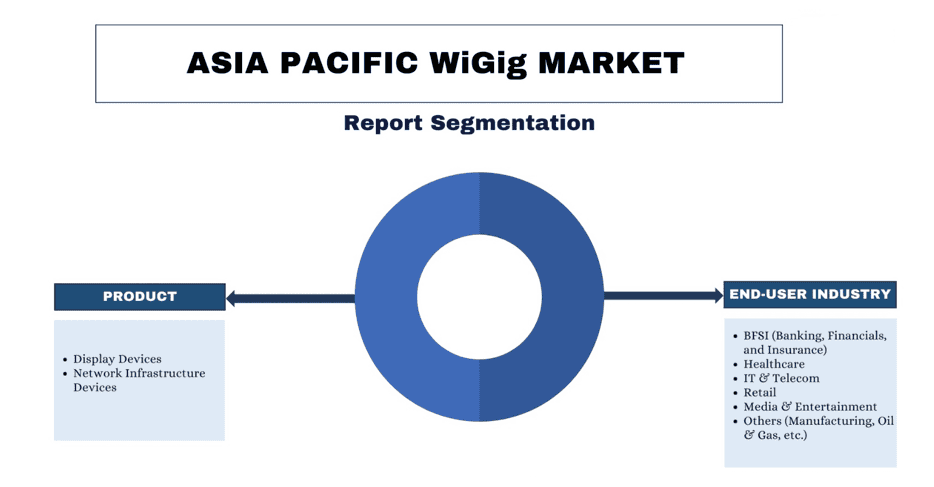
WiGig Market Trends
This section discusses the key market trends that are influencing the various segments of the WiGig Market as identified by our team of research experts.
The IT & Telecom Industry stands out as a major end-user segment for the WiGig worldwide.
Wireless Gigabit, also known as Wireless Gigabit Ethernet or Wi-Fi 6, is the latest iteration of Wi-Fi technology that offers significantly higher data transfer rates, improved network efficiency, and better performance in dense environments. With the ever-increasing reliance on cloud computing, remote collaboration, and data-intensive applications, the IT & telecom industry has recognized the critical importance of wireless gigabit technology. The IT & telecom industry deals with massive amounts of data, from cloud-based services and applications to video conferencing and real-time data transfer. Wireless gigabit technology offers data rates up to 9.6 Gbps, enabling seamless and uninterrupted data transmission, even in crowded environments. Wireless gigabit technology employs advanced techniques such as Orthogonal Frequency Division Multiple Access (OFDMA), Multi-User Multiple Input Multiple Output (MU-MIMO), and spatial reuse, resulting in improved network efficiency and reduced congestion. This is particularly important in the IT & telecom industry, where multiple devices and users often share the same network. Factors such as these are creating a favorable environment, fueling the boost in demand for WiGig by the IT & telecom industry.
China is the fastest-growing WiGig market worldwide.
Within Asia Pacific, China is the fastest-growing region. The major factor influencing the market’s growth is its mature digital infrastructure, coupled with its leadership in technological advancements has fostered the increasing need for high bandwidth data transfer capabilities, leading to a surge in the adoption of WiGig in the country.
Furthermore, the high proliferation of smartphones and other internet-enabled devices has driven the consumption of wireless data in the country. For instance, in 2022, China had approximately 1.03 billion smartphone users. Driving the need for more efficient wireless technology that can handle huge quantities of data transfer. This phenomenon is further fueled by the increased rate of 5G rollout. The rollout of 5G has enabled faster data speeds and lower latency, facilitating the consumption of high-bandwidth content and applications, further increasing the need for technologies such as WiGig. Additionally, China’s e-commerce market is the largest in the world, with sales reaching about USD 1.92 trillion in 2022. The widespread adoption of mobile payments and e-commerce platforms like Taobao, JD.com, and Pinduoduo has driven the need for reliable wireless connectivity that can manage powerful data analytics and data-intensive workloads. These developments along with others are fostering a favorable environment, boosting the demand for WiGig in the country.
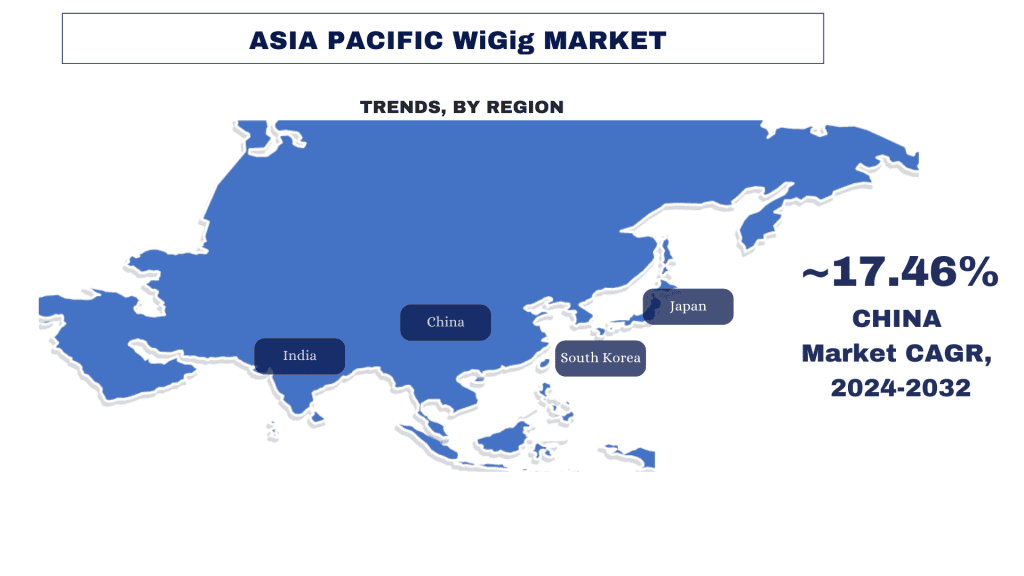
WiGig Industry Overview
The WiGig market is competitive and fragmented, with the presence of several Asia Pacific and international market players. The key players are adopting different growth strategies to enhance their market presence, such as partnerships, agreements, collaborations, new product launches, geographical expansions, and mergers and acquisitions. Some of the major players operating in the market are Panasonic Corporation; Fujikura Ltd.; Cisco Systems, Inc.; Dell Inc.; Intel Corporation; Qualcomm Technologies, Inc.; ASUSTeK Computer Inc.; TP-Link Corporation Limited; NETGEAR; and Lenovo.
Asia Pacific WiGig Market Report Coverage
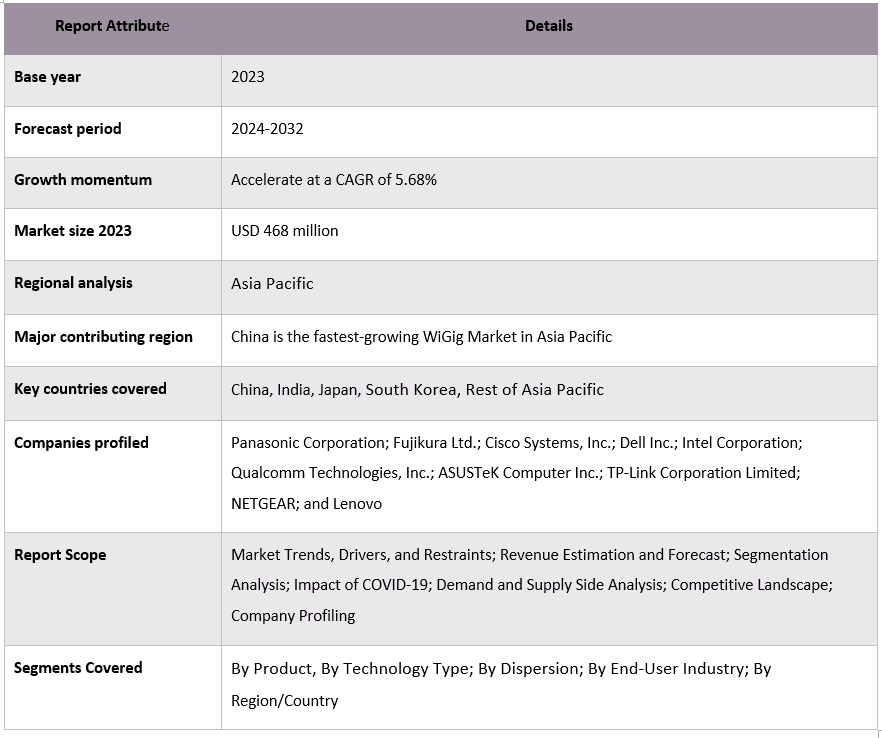
WiGig Market News
- In June 2023, Huawei, a Chinese vendor, unveiled its plans to release a series of commercial 5.5G network equipment in 2024. The announcement was made by Yang Chaobin, the director and president of ICT products and solutions at Huawei, during a presentation at MWC Shanghai 2023.
- In September 2023, Blu Wireless, a prominent participant in mmWave radio networking technology, unveiled PhantomBlu, the inaugural completely integrated LPD V-Band radio node that provides comprehensive 360° beamformed communications coverage.
Reasons to buy this report:
- The study includes market sizing and forecasting analysis validated by authenticated key industry experts.
- The report presents a quick review of overall industry performance at one glance.
- The report covers an in-depth analysis of prominent industry peers with a primary focus on key business financials, product portfolios, expansion strategies, and recent developments.
- Detailed examination of drivers, restraints, key trends, and opportunities prevailing in the industry.
- The study comprehensively covers the market across different segments.
- Deep dive regional level analysis of the industry.
Customization Options:
The Asia Pacific WiGig market can further be customized as per the requirement or any other market segment. Besides this, UMI understands that you may have your own business needs, hence feel free to contact us to get a report that completely suits your requirements.
Table of Content
Research Methodology for the WiGig Market Analysis (2024-2032)
Analyzing the historical market, estimating the current market, and forecasting the future market of the Asia Pacific WiGig market were the three major steps undertaken to create and analyze the adoption of WiGig in major regions of Asia Pacific. Exhaustive secondary research was conducted to collect the historical market numbers and estimate the current market size. Secondly, to validate these insights, numerous findings and assumptions were taken into consideration. Moreover, exhaustive primary interviews were also conducted, with industry experts across the value chain of the Asia Pacific WiGig market. Post assumption and validation of market numbers through primary interviews, we employed a top-down/bottom-up approach to forecasting the complete market size. Thereafter, market breakdown and data triangulation methods were adopted to estimate and analyze the market size of segments and sub-segments of the industry pertains to. Detailed methodology is explained below:
Analysis of Historical Market Size
Step 1: In-Depth Study of Secondary Sources:
A detailed secondary study was conducted to obtain the historical market size of the WiGig market through company internal sources such as annual reports & financial statements, performance presentations, press releases, etc., and external sources including journals, news & articles, government publications, competitor publications, sector reports, third-party database, and other credible publications.
Step 2: Market Segmentation:
After obtaining the historical market size of the WiGig market, we conducted a detailed secondary analysis to gather historical market insights and share for different segments & sub-segments for major regions. Major segments are included in the report as product, technology type, and end-user industry. Further country-level analyses were conducted to evaluate the overall adoption of testing models in that region.
Step 3: Factor Analysis:
After acquiring the historical market size of different segments and sub-segments, we conducted a detailed factor analysis to estimate the current market size of the WiGig market. Further, we conducted factor analysis using dependent and independent variables such as product, technology type, and end-user industry of the WiGig market. A thorough analysis was conducted of demand and supply-side scenarios considering top partnerships, mergers and acquisitions, business expansion, and product launches in the WiGig market sector across the globe.
Current Market Size Estimate & Forecast
Current Market Sizing: Based on actionable insights from the above 3 steps, we arrived at the current market size, key players in the Asia Pacific WiGig market, and market shares of the segments. All the required percentage shares split and market breakdowns were determined using the above-mentioned secondary approach and were verified through primary interviews.
Estimation & Forecasting: For market estimation and forecast, weights were assigned to different factors including drivers & trends, restraints, and opportunities available for the stakeholders. After analyzing these factors, relevant forecasting techniques i.e., the top-down/bottom-up approach were applied to arrive at the market forecast for 2030 for different segments and sub-segments across the major markets of Asia Pacific. The research methodology adopted to estimate the market size encompasses:
- The industry’s market size, in terms of revenue (USD) and the adoption rate of the WiGig market across the major markets domestically
- All percentage shares, splits, and breakdowns of market segments and sub-segments
- Key players in the Asia Pacific WiGig market in terms of products offered. Also, the growth strategies adopted by these players to compete in the fast-growing market.
Market Size and Share Validation
Primary Research: In-depth interviews were conducted with the Key Opinion Leaders (KOLs) including Top Level Executives (CXO/VPs, Sales Head, Marketing Head, Operational Head, Regional Head, Country Head, etc.) across major regions. Primary research findings were then summarized, and statistical analysis was performed to prove the stated hypothesis. Inputs from primary research were consolidated with secondary findings, hence turning information into actionable insights.
Split of Primary Participants in Different Regions
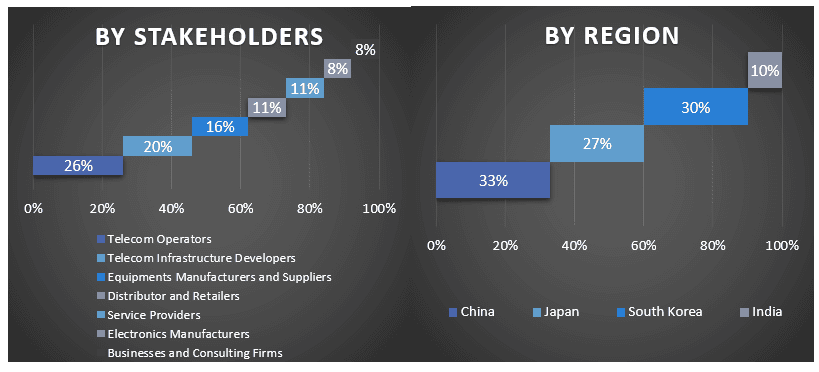
Market Engineering
The data triangulation technique was employed to complete the overall market estimation and to arrive at precise statistical numbers for each segment and sub-segment of the Asia Pacific WiGig market. data was split into several segments & sub-segments after studying various parameters and trends in the areas of product, technology type, and end-user industry in the Asia Pacific WiGig market.
The main objective of the Asia Pacific WiGig Market Study
The current & future market trends of the Asia Pacific WiGig market were pinpointed in the study. Investors can gain strategic insights to base their discretion for investments on the qualitative and quantitative analysis performed in the study. Current and future market trends determined the overall attractiveness of the market at a regional level, providing a platform for the industrial participant to exploit the untapped market to benefit from a first-mover advantage. Other quantitative goals of the studies include:
- Analyze the current and forecast market size of the WiGig market in terms of value (USD). Also, analyze the current and forecast market size of different segments and sub-segments.
- Segments in the study include areas of product, technology type, and end-user industry.
- Define and analyze the regulatory framework for the WiGig
- Analyze the value chain involved with the presence of various intermediaries, along with analyzing customer and competitor behaviors of the industry
- Analyze the current and forecast market size of the WiGig market for the major region
- Major countries of regions studied in the report include Asia Pacific, Europe, North America, and the Rest of the World
- Company profiles of the WiGig market and the growth strategies adopted by the market players to sustain in the fast-growing market.
- Deep dive regional level analysis of the industry
Related Reports
Customers who bought this item also bought










